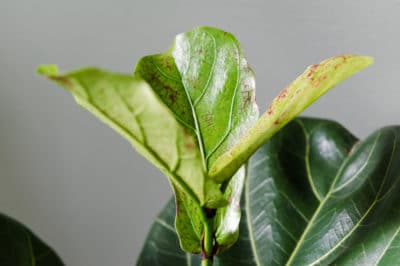What is a Fiddle Leaf Fig?
In its native habitat, the fiddle leaf fig produces both flowers and inedible fruits. Indoors, it will not produce either, but is valued for its shiny, distinctive leaves. A member of the banyan group, fiddle leaf figs grow high in trees – like orchids – and eventually send roots to the ground, strangling the host tree. The name comes from the leaf shape, which resembles a fiddle or violin.
How Do I Care for Fiddle Leaf Fig?
Indoors, a fiddle leaf fig needs bright indirect light for best growth and health. Keep the plant slightly on the dry side, watering only when the top inch of soil is dry. Use a balanced organic houseplant fertilizer with an NPK ratio of 20-20-20. Dilute to half strength with water and substitute the solution for a normal watering.
Can Fiddle Leaf Fig be Grown Outdoors?
Native to tropical rainforests, the fiddle leaf fig can be grown outdoors in warmer climates. It can also be grown in a container and moved outdoors for the summer. The fiddle leaf fig is considered hardy in USDA Zones 10 to 12, but it usually grows best in Zones 10b to 11. In Zone 12, it is more likely to develop sunburn, so grow in dappled shade.
Are There Different Varieties?
Although only one fiddle leaf fig variety is known to exist, the plant has three different growing patterns:
- Bush – these are younger plants, about 18 to 24 inches tall; typically used on table tops or shelves.
- Tree – an older version, these have a bare trunk with leaves at the top. May grow eight to 10 feet tall.
- Multiple Trunks – some fiddle leaf figs will develop more than one trunk from their roots.
Can Over-Watering Cause Brown Spots?
Over-watering is the number-one houseplant killer. Fiddle leaf figs are more susceptible than some to too much water, especially if the water stands around their roots. The excess water means the plant can’t get enough oxygen, and to protect itself, it will start to lose leaves. It’s common for the edges to turn brown first – then the brown spreads throughout the leaf.
Can Diseases Cause Brown Spots?
Brown leaves in a fiddle leaf fig may be caused by a bacterial infection from Xanthomonas campestris. The spots will be tan to brown and the leaf margins will be irregular. A serious infection can completely cover young leaves. Good sanitation is the best prevention. Remove damaged or fallen leaves, keep water off leaves when watering and don’t overdo fertilizer as it causes lush growth.
What About Fungal Disorders?
Root rot and anthracnose leaf spot are fungal diseases that can cause brown spots on the leaves of a fiddle leaf fig. Both show up as brown spots on the leaves, but leaf spot also causes black spots, which are the fungal colonies. Root rot results from over-watering; cut back on the water to solve the problem. Leaf spot occurs when leaves are splashed during the watering process.
Can Insects Cause Brown Spots?
Mites and mealybugs can attack fiddle leaf figs. The insects themselves are so small you usually can’t see them. Mealybug colonies may look like a small puff of cotton at the leaf joints. The tip-off is the appearance of brown spots from the insects’ feeding, especially on the young, tender leaves they prefer. Treat both insects with an insecticidal soap spray.
Do Brown Spots Cause Leaf Drop?
Brown spots in and of themselves don’t cause leaf drop. However, the condition causing the spots in the first place may result in dropping leaves. Over-watering, for example, is a systemic issue. The plant will drop leaves and if the situation is not rectified, eventually the plant will die.
Can I Just Cut Off the Brown Spots?
Cutting off brown spots might be fine – then again, it might not. It depends on why the plant has brown spots. Cutting the leaves when the plant has a bacterial infection is likely to spread the infection. If the plant is dropping leaves because it’s going dormant for the winter, you could trim back the drying leaves. The rule of thumb is, when in doubt – don’t cut.
